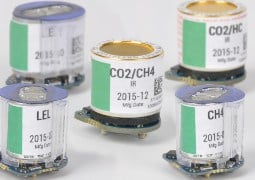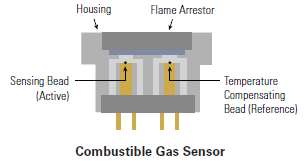There are many ways that sensors in a gas detector can go bad. You might drop an instrument and damage the sensor inside. You might be in an environment where the ambient gas can poison sensors. You might be in a high humidity environment that can affect the accuracy of gas readings. All these external and environmental effects important to consider, but have you ever had to service or replace a gas detector because the oxygen sensor was simply “too old”?
Traditional Oxygen Sensors
Oxygen sensors, like all other electrochemical sensors, lose sensitivity after long periods of use. Traditional O2 sensors last, on average, around 2 years, but compared to other electrochemical sensors, such as H2S and CO which last typically over 4 years, the O2 sensor under-performs. Aged O2 sensors are one of the most common failures in gas detectors, and can be a pain point for users who have to constantly spend time and money to have sensors replaced. Luckily, there are now long-life O2 sensors for gas detectors, something that users have wanted for quite some time.
Long-Life Oxygen Sensors
Long-life oxygen sensors are a newer way for gas detector users to address one of their biggest pain points. With proper maintenance (like calibrating and bump testing), these sensors can last up to five years, a significant step up from the typical two-year life span. A longer lasting sensor can lead to fewer failures, less time spent on servicing instruments, and less money spent on repairs and replacements. Additionally, these longer lasting oxygen sensors are usually lead-free, a great benefit for the environment. There is also little difference in price between these and the traditional O2 sensors.

The long-life oxygen sensor is designed to perform
in the field for three to five years, solving the common
gas detection industry problem of traditional oxygen
sensor failure after eighteen to thirty months of use.
The lead-free, long-life O2 sensors are an improvement over traditional O2sensors, but they do function differently because they are biased sensors.
- They consume battery power when the instrument is powered off
- They need time to warm up under certain conditions
Although these differences might sound disconcerting, they are likely minor to the majority of gas detection users.
Why Biased Sensors?
So why does the sensor consume battery power when the instrument isn’t turned on? The sensor is a biased, which means that the reference electrode requires more positive potential than the sensing electrode (600mV above the sensing electrode). The sensor needs to be biased in order to remain stable and produce accurate readings. When the instrument is on and functioning, the sensor gets enough current to remain biased. When the instrument is powered off, the sensor draws battery power in an effort to keep itself stable. Based on testing, a fully charged instrument will have one hour of run time remaining after 15 days of unpowered storage, so the impact on the battery power is minimal. The biased sensor also does not negatively impact instrument run time.
What about the warm up time? Again, these sensors require constant current draw to remain charged. For example, if the instrument battery goes dead for any reason, after the user either replaces or charges the battery and turns on the instrument, the instrument will require some time for the sensor to stabilize. The time it takes for the sensor to stabilize varies depending on how long the instrument was dormant for. The following table describes how long sensor stabilization typically takes.
| UNPOWERED TIME | CHARGING TIME TO STABILIZE |
| 15 Minutes | 15 Minutes |
| 1 Hour | 25 Minutes |
| 10 Hours | 75 Minutes |
| 1 Day | 2 Hours |
| 1 Week | 3 Hours |
Sensor stabilization is also required when one of these long-life O2 sensors needs to be replaced. When the old oxygen sensor is nearing its end of life, the user may order a replacement sensor. The long-life O2 replacement sensor comes with a coin cell battery that keeps the sensor biased until it is installed in an instrument. Even with the coin cell battery, when the sensor is replaced, the instrument will bias the sensor to stabilize it to its optimal level. This process typically takes less than 15 minutes.
Biased oxygen sensor readings will become unstable if:
- The battery has been removed from the instrument for a period time
- The instrument is powered off after the critical battery warning
With all that said, if users keep their instruments charged and functional, they should not have to worry about the differences in use or functionality.
The long-life oxygen sensor does have its differences from the traditional oxygen sensor, but it provides users with several advantages like fewer sensor failures, less time in service, less money spent on repairs, and less environmental impact. With proper calibration, bump testing, and gas detector maintenance, the long-life oxygen sensor can greatly benefit users, and most importantly, keep them safe.
Want to learn about what could be poisoning your sensors? Read about common sensor poisons and inhibitors.



